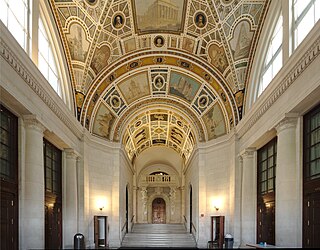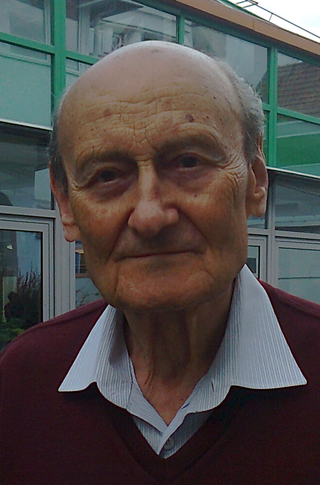
Carnegie Mellon University (CMU) is a private research university in Pittsburgh, Pennsylvania. The institution was established in 1900 by Andrew Carnegie as the Carnegie Technical Schools. In 1912, it became the Carnegie Institute of Technology and began granting four-year degrees. In 1967, it became Carnegie Mellon University through its merger with the Mellon Institute of Industrial Research, founded in 1913 by Andrew Mellon and Richard B. Mellon and formerly a part of the University of Pittsburgh.

The School of Computer Science (SCS) at Carnegie Mellon University in Pittsburgh, Pennsylvania, US is a school for computer science established in 1988. It has been consistently ranked among the best computer science programs over the decades. As of 2024 U.S. News & World Report ranks the graduate program as tied for No. 1 with Massachusetts Institute of Technology, Stanford University and University of California, Berkeley.

The College of Fine Arts (CFA) at Carnegie Mellon University in Pittsburgh, in the U.S. state of Pennsylvania oversees the Schools of Architecture, Art, Design, Drama, and Music along with its associated centers, studios, and galleries.
Robert Wesley Wilson was an American artist and one of the leading designers of psychedelic posters. Best known for designing posters for Bill Graham of The Fillmore in San Francisco, he invented a style that is now synonymous with the peace movement, the psychedelic era and the 1960s. In particular, he was known for inventing and popularizing a "psychedelic" font around 1966 that made the letters look like they were moving or melting.
John Rhys Coiro is an American film, television, and stage actor. He began acting on Broadway but is best known for on-screen roles such as Billy Walsh on the television series Entourage.

The School of Design at Carnegie Mellon University is a degree-granting institution within a private university in Pittsburgh, Pennsylvania, United States. The School of Design is one of five schools within the Carnegie Mellon College of Fine Arts offering both under and post graduate education. The School is accredited by Middle States Association of Colleges and Schools and awards BDES, MA, MDES, MPS, MII-PS, DDES, and PhD degrees. The School of Design has 21 full-time and 10 adjunct faculty.

The Human–Computer Interaction Institute (HCII) is a department within the School of Computer Science at Carnegie Mellon University (CMU) in Pittsburgh, Pennsylvania. It is considered one of the leading centers of human–computer interaction research, and was named one of the top ten most innovative schools in information technology by Computer World in 2008. For the past three decades, the institute has been the predominant publishing force at leading HCI venues, most notably ACM CHI, where it regularly contributes more than 10% of the papers. Research at the institute aims to understand and create technology that harmonizes with and improves human capabilities by integrating aspects of computer science, design, social science, and learning science.
The Dickson Prize in Medicine and the Dickson Prize in Science were both established in 1969 by Joseph Z. Dickson and Agnes Fischer Dickson.
Ralph Guggenheim is an American video graphics designer and film producer. He won a Producers Guild of America Award in 1995 for his contributions to the film Toy Story.
Fantasy Unlimited was a multimedia artists collective in New York.

Kushagra Nayan Bajaj is the Promoter and Non-Executive Chairman of the Bajaj Group of Companies which includes Bajaj Hindusthan Sugar Limited, Bajaj Consumer Care Limited, and Bajaj Energy Limited.

Egon Balas was an applied mathematician and a professor of industrial administration and applied mathematics at Carnegie Mellon University. He was the Thomas Lord Professor of Operations Research at Carnegie Mellon's Tepper School of Business and did fundamental work in developing integer and disjunctive programming.

Robert Lepper (1906-1991) was an American artist and art professor at Carnegie Institute of Technology, now Carnegie Mellon University, who developed the country's first industrial design degree program. Lepper's work in industrial design, his fascination with the impact of technology on society and its potential role for artmaking formed the background for his class "Individual and Social Analysis", a two semester class focusing on community and personal memory as factors in artistic expression, which with his theoretical dialogues with his most promising students outside the classroom fostered the intellectual environment from which such diverse artists as Andy Warhol, Philip Pearlstein, Mel Bochner, and Jonathan Borofsky would later build their art practices.
Srikant Datar is an Indian-American economist and the Dean of Harvard Business School. At Harvard, he concurrently serves as the Arthur Lowes Dickinson Professor of Business Administration.

Molly Wright Steenson is an American professor of design and a historian of architecture and technology. Currently, Molly is the president and CEO of the American Swedish Institute. Previously, she was the Carnegie Mellon University Vice Provost for Faculty, K&L Gates Associate Professor of Ethics and Computational Technologies, and Senior Associate Dean for Research in the College of Fine Arts at Carnegie Mellon University.
Roni Rosenfeld is an Israeli-American computer scientist and computational epidemiologist, currently serving as the head of the Machine Learning Department at Carnegie Mellon University. He is an international expert in machine learning, infectious disease forecasting, statistical language modeling and artificial intelligence.
Advanced Robotics for Manufacturing (ARM), also known as ARM Institute, is a consortium created in 2017 through a Department of Defense grant won by Carnegie Mellon University. ARM is structured as a public-private partnership and the Manufacturing USA Institutes, a network of 16 institutes dedicated to advancing technologies used in manufacturing. ARM was the 14th institute created and focuses on funding innovations in robotics and workforce development.
John Shaffner is an American production designer and art director. He has worked on 44 different television series as well as 68 pilots.
Bill Mayer is an American illustrator who works in a variety of media and combinations of media, gouache, oil, airbrush, scratchboard, pen and ink and digital, as well as a variety of artistic styles. In 2021, he received the Hamilton King Award.
J. David Creswell is an American social psychologist, professor, author, and entrepreneur. He is most known for his work on mindfulness, meditation, equanimity, and stress resilience. He is currently a professor of psychology at Carnegie Mellon University, where he runs the Health and Human Performance Lab. He is also the Co-Founder and Head of Science of Equa Health, a personal mindfulness training app.








